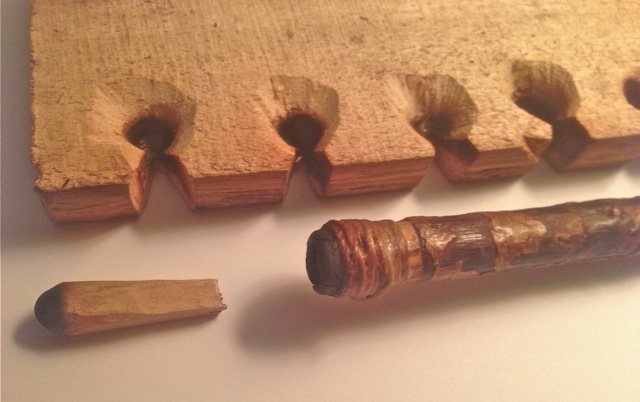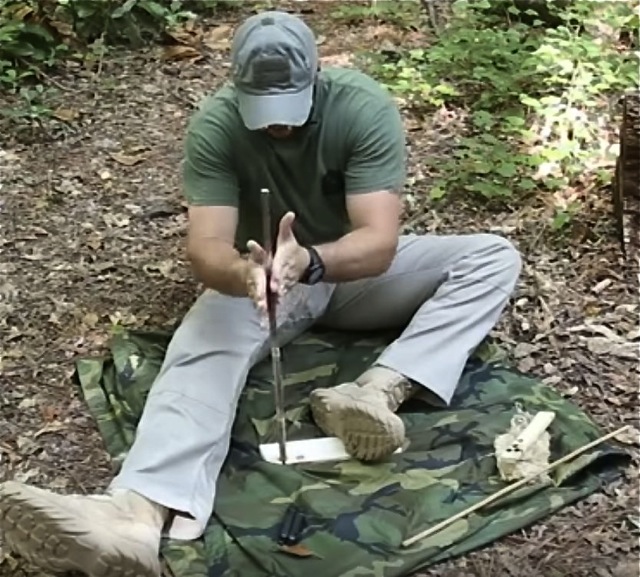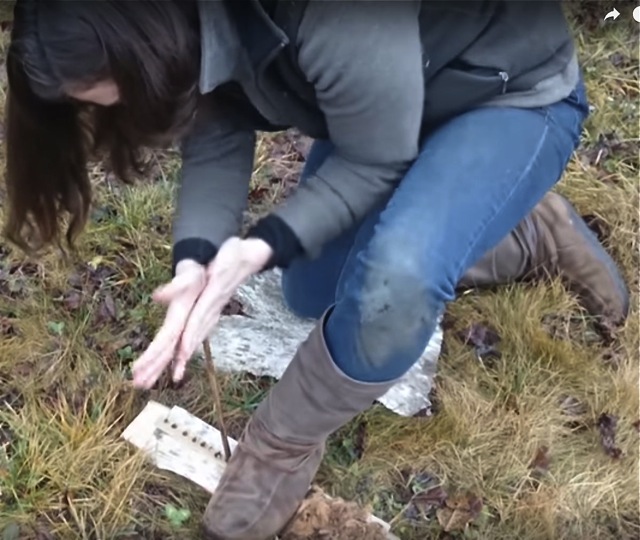
I would like to present some techniques for making it easier to start a hand drill fire when you aren't as young as you used to be.
Remember when you could walk into the woods, bash two rocks together to get a sharp edge, used the sharp edge to prepare a spindle and hearthboard and then use brute strength to twirl up a glowing ember? Those were the days . . . . long gone. That was forty years ago. Welcome to the club. You have terminal sarcopenia along with everything else that comes with age. Sarcopenia is the medical term for the inexorable loss of muscle strength with age. Another manifestation of this is how your maximum heart rate diminishes with age. One rule of thumb says that your maximum heart rate is roughly equal to 220 minus your age. Yes, all the world champion athletes are pretty young.
After doing it for almost forty years I still get a tremendous thrill out of starting a fire with a hand drill, but I don't have the muscle power any more. So, I try to substitute finesse for brute strength. First of all I'm generally doing it as a demonstration for a group of people rather than on some buck-naked jaunt into the wilderness so I do it the way Tom Sawyer painted the picket fence: get someone else to do most of the work. The most common situation is a demonstration for third graders (about 8-year -old) who are learning about the people indigenous to the San Francisco Bay region (Ohlone tribe primarily). I get around twelve of the little dears to take turns twirling the spindle and warming things up for me. While the students are twirling I hold the spindle down with a stone socket. This is necessary because at that early age they don’t have sufficient coordination to keep the spindle seated on the hearthboard. Then, I take over and twirl up an ember.
Another important aspect is to select materials and dimensions that minimize the physical effort required. In general, that means using a hearthboard and spindle made from materials that are good insulators and consequently rather soft. That is so that a given human effort will cause the highest temperature rise. I have had the best results with hearthboards made from cottonwood roots, willow roots and California incense cedar wood. The replaceable tips of the spindle are mule fat (Baccharus viminea), also known a seep willow. It is a shrub that grows in creek beds in the southwest where it is exposed to full sun. The diameter of the tip where it meets the hearthboard is only 5/16 in. (.79 cm.) and it is connected to a wild rose spindle 31 in. (78 cm.) long that tapers from 6/16 in. to 7/16 in. (.95 to 1.11 cm.). Small diameter means more horsepower per unit area and consequently greater temperature rise. Find out what works best in your area and remember that tree roots tend to be softer and better insulators than wood from the trunk. Also, material that sits on the ground for a few years and partly decomposes is also less dense than wood freshly harvested. The replaceable tip, shown in Figure 1, has a pyramidal taper that fits snugly into the bottom of the spindle which has a square tapered hole. The cottonwood root hearthboard is about 1/2 in. (1.27 cm.) thick and with that thickness I can get typically two embers from each hole.

Figure 1. Hearthboard, replaceable tip & spindle.
Good ergonomics is also important. Get your body in the right position. If you are very strong, then use brute force, but if you're short on muscle power, then do it right. Compare Figure 2a with 2b, lifted from YouTube videos. The person in Figure 2a is sitting on his fanny with his heel holding the hearthboard in place. Consequentl, he has to extend his arms to twirl the spindle. This puts a great burden on his pectoral muscles. But, what muscles! His arm muscles are twice as big as mine. In contrast, the young woman in Figure 2b gets up off her tail and used her left foot to hold the hearthboard down to put herself in the position where the spindle is closer to her body. Thus, her pectoral muscles don't have to work as hard. That's the position you should use in your declining years. Also, longer spindles take less physical effort than shorter ones and allow a lengthier period of rotation before having to move back up to the top of the spindle. No, I didn’t mention the "floating" method, wherein your palms stay more or less at the same position on the spindle simply because I’m not very good at it.

Figure 2a.

Figure 2b.
Hand slippage: When your hands are too dry, they cannot get a good grip on the spindle. A bit of spit has been the standard remedy for millennia, but what about something a bit tidier? Imagine how the parents and teachers would react if I told my little helpers to spit on their hands. That’s unsanitary! So . . . . I have someone with a damp sponge at the ready to dampen their hands. Furthermore, I rub beeswax into the 31 inch wild rose spindle to make it much less slippery and put a light coat of tincture of benzoin on my hands. Tincture of benzoin is readily available at your local pharmacy and is typically used for skin toughening.
More technique: With the cottonwood root hearthboard and a small diameter spindle, I sometimes fail to reach ignition because of too much effort. Clearly, if one doesn't work hard enough there will be insufficient temperature rise to reach the temperature (~ 700 degrees F) needed for ignition. If one applies too much effort, then the material will be worn away before it reaches the ignition temperature. There is a sweet spot. I have learned to twirl just hard enough to maintain a fairly steady small amount of smoke.
Experiment!
E-mail your comments to "Richard A. Baugh" at richardbaugh@att.net
We hope the information on the PrimitiveWays website is both instructional and enjoyable. Understand that no warranty or guarantee is included. We expect adults to act responsibly and children to be supervised by a responsible adult. If you use the information on this site to create your own projects or if you try techniques described on PrimitiveWays, behave in accordance with applicable laws, and think about the sustainability of natural resources. Using tools or techniques described on PrimitiveWays can be dangerous with exposure to heavy, sharp or pointed objects, fire, stone tools and hazards present in outdoor settings. Without proper care and caution, or if done incorrectly, there is a risk of property damage, personal injury or even death. So, be advised: Anyone using any information provided on the PrimitiveWays website assumes responsibility for using proper care and caution to protect property, the life, health and safety of himself or herself and all others. He or she expressly assumes all risk of harm or damage to all persons or property proximately caused by the use of this information.
© PrimitiveWays 2016